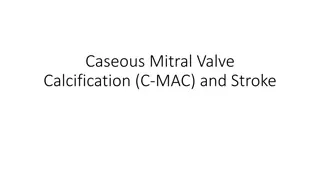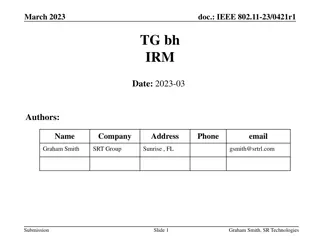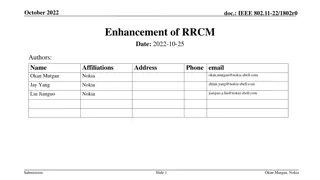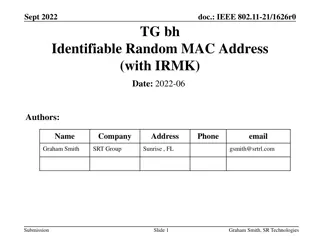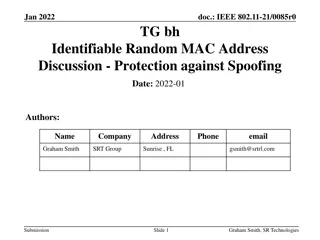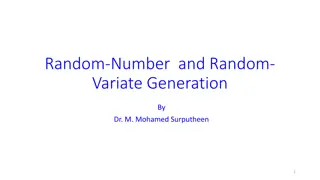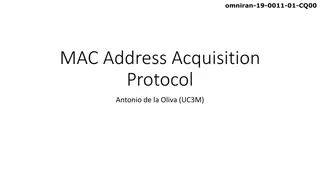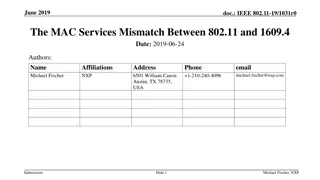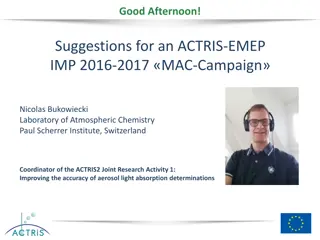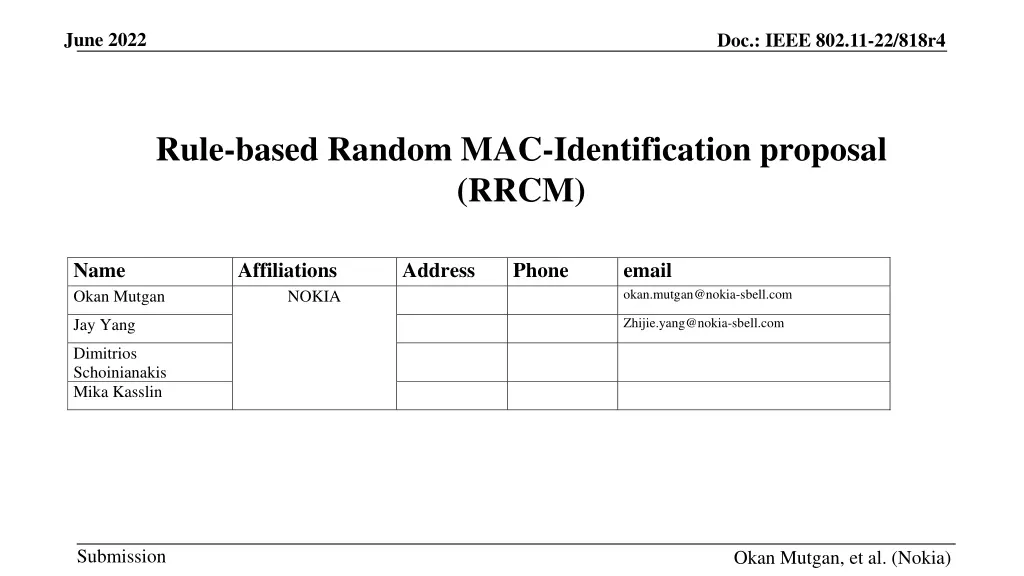
Enhancing Privacy in IEEE 802.11 Networks with Rule-Based MAC Identification
"Learn about a proposed rule-based Random MAC Identification (RRCM) mechanism in IEEE 802.11 to improve privacy by generating Random Mac Addresses (RMA) for non-AP STA. Explore the motivation, background, and implementation details of this innovative solution."
Download Presentation

Please find below an Image/Link to download the presentation.
The content on the website is provided AS IS for your information and personal use only. It may not be sold, licensed, or shared on other websites without obtaining consent from the author. If you encounter any issues during the download, it is possible that the publisher has removed the file from their server.
You are allowed to download the files provided on this website for personal or commercial use, subject to the condition that they are used lawfully. All files are the property of their respective owners.
The content on the website is provided AS IS for your information and personal use only. It may not be sold, licensed, or shared on other websites without obtaining consent from the author.
E N D
Presentation Transcript
June 2022 Doc.: IEEE 802.11-22/818r4 Rule-based Random MAC-Identification proposal (RRCM) Name Okan Mutgan Affiliations NOKIA Address Phone email okan.mutgan@nokia-sbell.com Jay Yang Zhijie.yang@nokia-sbell.com Dimitrios Schoinianakis Mika Kasslin Submission Okan Mutgan, et al. (Nokia)
June 2022 Doc.: IEEE 802.11-22/818r4 Abstract This Document focuses on a specific solution (v3) presented in 22/818r3. Rule-based Random and Changing MAC Address (RRCM) A privacy enhancement mechanism for non-AP STA and AP to generate one or more Random Mac Addresses (RMA) for use by non-AP STA to prevent non-AP STA from being tracked (by third parties) and still allow the non-AP STA to be identified by the AP in subsequent message exchanges. Rule-based implies that the non-AP STA and AP apply the same procedures for generating RMA or RMA(s) locally at their sides. Submission
June 2022 Doc.: IEEE 802.11-22/818r4 Background-1 Conventional 802.11 standards are designed in a way that each STA uses its own fixed unencrypted MAC address. This causes a privacy concern such as allowing others to track STAs based on their MAC address. To reduce this privacy risk, using MAC randomization (STAs using random MAC address) became a common technique. Within this context, 11bh focuses on the identification issue on the STA with Random Mac Address (RMA), and several use cases are defined in 332r37: The STA uses a MAC address in the first-time association, and connects to AP. After a while, STA disassociates and wants to connect to the AP with a new MAC address (RMA). In this scenario, how can AP identify the STA with its new MAC address (RMA) privately? Submission
June 2022 Doc.: IEEE 802.11-22/818r4 Background-2 802.11bh D0.2 provides a device ID solution, which covers use cases that the identification happening after association. the identification based on probing (pre-association & post-association) is not addressed. the identification on authentication/(re)association is not addressed. Submission
June 2022 Doc.: IEEE 802.11-22/818r4 Motivation We propose a rule-based mechanism to identify a STA with its random MAC address. Basic Idea, STA and AP generate one or more RMA(s) locally at their sides using, Key (RMA key) locally generated private key Seed exchanged between two sides to feed into RMA generation formula Counter exchanged between two sides to make sure both sides generate the same number of RMA(s) The STA will use the generated RMA(s) in its next association. Since AP also generates the same RMA(s), it will identify the STA. If STA generates a single RMA -> STA can use it in all message exchanges If STA generates multiple RMA(s) -> STA can use them in different message exchanges (e.g. RMA1 in probe request frame, RMA2 in other frames). Submission
June 2022 Doc.: IEEE 802.11-22/818r4 RRCM Procedure In current Association, STA and AP generate the same key (RMA Key, i.e. RMAK) locallybased on KDK (RMAK is not shared). RMAK = KDF-Hash-256(KDK, "RMA Key", Min(ANonce, SNonce) || Max(ANonce, SNonce) This will output 256 bits RMAK. STA behavior: - STA generates one or more RMA(s) locally decided by STA- based on: RMAn = KDF-Hash-48(RMAK, "Next RMAs", seed || n), seed is 128- bit random string n is initialized with 1 and incremented by 1 until n is equal to Counter, which is the number of generated RMA(s). As an example, Counter = 3 -> n=1 :: RMA1, n=2 :: RMA2, n=3 :: RMA3. - STA sends {Seed, Counter} to AP in encrypted 4-way HS Msg2 (except RRCM IE in Assoc Req for FILS) AP behavior: - AP checks {Counter} to determine how many RMAs it should generate. Then it uses {Seed, Counter} to generate the same RMA(s) that STA generated. RMAn = KDF-Hash-48(RMAK, "Next RMAs", seed || n), Submission
June 2022 Doc.: IEEE 802.11-22/818r4 RRCM Procedure In next Association, STA uses the generated RMA(s) freely. As an example, Implementation 1 RMA1 for Probe Req (unicast or broadcast) RMA2 for Auth/Assoc/4-way HS/Data Connection Implementation 2 RMA1 for Probe Req (unicast or broadcast) for 3 hours RMA2 for Probe Req (unicast or broadcast) for another 3 hours RMA3 for Auth/Assoc/4-way HS/Data Connection. STA re-generates {Seed, Counter} and sends them to AP in encrypted 4-way HS Msg2 (except RRCM IE in Assoc Req for FILS). AP and STA generates new RMA(s) for future use (next association). Note: Normally, PTK is partitioned into KCK, KEK, TK. However, when WUR is negotiated, The PTK is partitioned into KCK, KEK, TK, and a KDK. Similarly, when RRCM is negotiated, The PTK is partitioned into KCK, KEK, TK, and a KDK. KDK is used to derive RMAK. Submission
June 2022 Doc.: IEEE 802.11-22/818r4 RRCM Procedure RRCM KDE in 4-way HS (scenarios other than FILS) Seed Counter Octets 16 2 RRCM IE in Association Request (for FILS) Element ID Length Element ID Extension Seed Counter Octets 1 1 1 16 2 Submission
June 2022 Doc.: IEEE 802.11-22/818r4 RRCM Procedure Example Diagram (two RMAs generation) Prob/Auth/Ass Req/Resp - MAC1 AP STA1 PTK::RMAK RMAn = KDF-Hash-48(RMAK, "Next RMAs", seed || n) where n (counter) and seed received from STA. [RMA1 = KDF-Hash-48(RMAK, "Next RMAs", seed || 1) RMA2 = KDF-Hash-48(RMAK, "Next RMAs", seed || 2)] PTK::RMAK 4-way Handshake MAC1 ({seed, counter} sent in encrypted Msg2 from STA to AP) RMAn = KDF-Hash-48(RMAK, "Next RMAs", seed || n) where n is the value of counter. [RMA1 = KDF-Hash-48(RMAK, "Next RMAs", seed || 1) RMA2 = KDF-Hash-48(RMAK, "Next RMAs", seed || 2)] Data Connection MAC1 Disconnect Map RMA1, RMA2 -> STA1 Prob RMA1, Auth/Ass Req/Resp RMA2 AP receives RMA1from probe req and identifies the STA (i.e. STA1). AP also receives RMA2 from other frames and identifies the STA (i.e. STA1) 4-way Handshake RMA2 ({seed, counter} sent in encrypted Msg2 from STA to AP) Data Connection RMA2 Submission
June 2022 Doc.: IEEE 802.11-22/818r4 Reference [1] 802.11bh draft 0.2 [2]11-22-0296-08-00bh-tgbh-proposals.pptx [3] 11-21-0332-37-00bh-issues-tracking.docx Submission
June 2022 Doc.: IEEE 802.11-22/818r4 THANK YOU Submission









